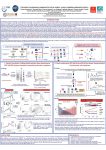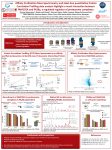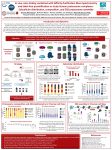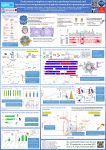 In the goal to efficiently purify all endogenous human proteasome complexes, we have optimized an affinity purification-mass spectrometry (AP-MS) strategy involving in vivo formaldehyde crosslinking to maintain the labile interactions between the 20S core complex and the regulatory complexes (Bousquet-Dubouch et al. Mol Cell Proteomics. 2009 May;8(5):1150-64). The dynamics of proteasome complexes have further been studied in space and time (Fabre et al. Mol. Cell Proteomics 2013). Proteasome activity is regulated at different levels by variations in the composition of 20S catalytic subunits, in the stoichiometry of bound regulators, and in the rate of the 20S catalytic core complex assembly (Fabre et al. J.Proteome Res. 2014).
In the goal to efficiently purify all endogenous human proteasome complexes, we have optimized an affinity purification-mass spectrometry (AP-MS) strategy involving in vivo formaldehyde crosslinking to maintain the labile interactions between the 20S core complex and the regulatory complexes (Bousquet-Dubouch et al. Mol Cell Proteomics. 2009 May;8(5):1150-64). The dynamics of proteasome complexes have further been studied in space and time (Fabre et al. Mol. Cell Proteomics 2013). Proteasome activity is regulated at different levels by variations in the composition of 20S catalytic subunits, in the stoichiometry of bound regulators, and in the rate of the 20S catalytic core complex assembly (Fabre et al. J.Proteome Res. 2014).
 The PCP method has been further used to highlight new proteasome interacting proteins. In collaboration with O. Coux (CRMB, Montpellier), we have shown that FAM192a, a nuclear protein of previously unknown function that we renamed PIP30, is a major regulator of PA28γ functions (Jonik-Nowak B., Menneteau T. et al. Proceeding of the National Academy of Sciences 2018).
The PCP method has been further used to highlight new proteasome interacting proteins. In collaboration with O. Coux (CRMB, Montpellier), we have shown that FAM192a, a nuclear protein of previously unknown function that we renamed PIP30, is a major regulator of PA28γ functions (Jonik-Nowak B., Menneteau T. et al. Proceeding of the National Academy of Sciences 2018).
 The dynamics of proteasome complexes have further been studied in space and time (Fabre et al. Mol. Cell Proteomics 2013. DOI: 10.1074/mcp.M112.023317). Proteasome activity is regulated at different levels by variations in the composition of 20S catalytic subunits, in the stoichiometry of bound regulators, and in the rate of the 20S catalytic core complex assembly (Fabre et al. J.Proteome Res. 2014).
The dynamics of proteasome complexes have further been studied in space and time (Fabre et al. Mol. Cell Proteomics 2013. DOI: 10.1074/mcp.M112.023317). Proteasome activity is regulated at different levels by variations in the composition of 20S catalytic subunits, in the stoichiometry of bound regulators, and in the rate of the 20S catalytic core complex assembly (Fabre et al. J.Proteome Res. 2014).
 We describe new structural and functional aspects of a poorly characterized subtype of proteasome found exclusively in germ cells. The spermatoproteasome was recently shown to be essential for spermatogenesis, a process requiring intense proteolysis. Intriguingly, it differs from the constitutive proteasome by only one subunit – α4s, a non-catalytic subunit which replaces the constitutive α4 subunit. Here, we use modern mass spectrometry strategies to examine how the shift from α4 to α4s affects/regulates proteasome composition, dynamics, interactome and activity. Our data reveals a more complex process of regulation than previously suggested and sets the basis for structural and functional specificities of the spermatoproteasome (Živković et al. PNAS 2022).
We describe new structural and functional aspects of a poorly characterized subtype of proteasome found exclusively in germ cells. The spermatoproteasome was recently shown to be essential for spermatogenesis, a process requiring intense proteolysis. Intriguingly, it differs from the constitutive proteasome by only one subunit – α4s, a non-catalytic subunit which replaces the constitutive α4 subunit. Here, we use modern mass spectrometry strategies to examine how the shift from α4 to α4s affects/regulates proteasome composition, dynamics, interactome and activity. Our data reveals a more complex process of regulation than previously suggested and sets the basis for structural and functional specificities of the spermatoproteasome (Živković et al. PNAS 2022).
 The proteasome represents a highly dynamic and adjustable platform for protein degradation. Indeed, a single mutation may be enough to disrupt the entire pathway and cause a wide range of diseases. Neurodevelopmental disorders (NDDs) comprise a broad spectrum of rare syndromes, that are difficult to diagnose and poorly characterized. Some of the NDD patients carry missense mutations in genes encoding proteasomal proteins and particularly those of the 26S. This study focuses on the molecular and structural characterization of NDD patients harboring mutations on the 20S core subunit β3 (P320R) and on the 19S subunit PSMC5 (R325W). We show that the studied mutations are responsible for defects in 20S-19S association and for 20S proteasome maturation, respectively (Küry et al. MedRxiv 2025).
The proteasome represents a highly dynamic and adjustable platform for protein degradation. Indeed, a single mutation may be enough to disrupt the entire pathway and cause a wide range of diseases. Neurodevelopmental disorders (NDDs) comprise a broad spectrum of rare syndromes, that are difficult to diagnose and poorly characterized. Some of the NDD patients carry missense mutations in genes encoding proteasomal proteins and particularly those of the 26S. This study focuses on the molecular and structural characterization of NDD patients harboring mutations on the 20S core subunit β3 (P320R) and on the 19S subunit PSMC5 (R325W). We show that the studied mutations are responsible for defects in 20S-19S association and for 20S proteasome maturation, respectively (Küry et al. MedRxiv 2025).
Through a collaboration with Prof. Silke Meiners’ team (Research Center Borstel/Leibniz Lung Center), funded by ANR-PA200_IN_IPF , we explored the role and regulation of the proteasome activator PA200 in tumor cell invasion and its function as a key regulator of the immunoproteasome:
The first study deals with the role of PA200 in tumor cell invasion. We show that PA200 is notably upregulated in non-small cell lung cancer (NSCLC) , correlating with poor prognosis. To investigate its role, PA200 was genetically depleted in two NSCLC cell lines, revealing cell-specific effects on proteasome regulation and growth. However, PA200 depletion consistently reduced tumor cell migration and invasion in vitro and slowed tumor growth in vivo. A PA200 inhibitor, Prest2-M17 , was identified, selectively inhibiting PA200-proteasome complexes with minimal impact on 20S catalytic activity. This compound reduced lung cancer cell invasiveness , highlighting PA200 as a promising therapeutic target in NSCLC. (Yazgili AS, Živković D. et al. BioRxiv 2025).
The second work reveals an unexpected interplay between PA200 and the immunoproteasome. While PA200’srole remains unclear and varies by cell type, recent evidence shows PA200 also interacts with the immunoproteasome (i20S), crucial for antiviral and antitumor immunity. Our study presents the first cryo-EM structures of i20S-PA200 complexes, revealing that PA200 binding triggers long-range allosteric changes in i20S but not in standard 20S. These changes increase PA200 occupancy on i20S, enhancing its activation. Mass photometry confirms stronger PA200 binding to i20S. While PA200 and i20S expression is limited to specific conditions, co-expression favors interaction. Notably, PA200 may regulate i20S gene expression , but not vice versa. This study highlights PA200 as a key regulator of i20S when both are co-expressed (Živković et al. BioRxiv 2025).
